The voice prompt is the component of the turn instruction that describes the movement the driver needs to take.
By default, the voice prompt for any given movement is automatically selected by Waze.
In some cases, however, the "Waze selected" voice prompt is not the best instruction for the driver. In these cases, the "Waze selected" voice prompt can be overridden (VPO) in the Waze Map Editor to better match the reality of the road.
Principles
The voice prompt gives the Wazer a general idea of the movement they are going to make at the next junction that requires their action. Often, the default "Waze selected" voice prompt will be the best representation of this movement.
At times, however, the default "Waze selected" voice prompt might give a confusing movement instruction, or no instruction at all. The voice prompt override was developed for uncommon situations where Waze's default voice prompt could confuse the average Wazer.
Note, however, that overriding the voice prompt should generally be carefully considered on a movement-by-movement basis, not used broadly to force an alternative instruction style when typical Wazers are already accustomed to and reasonably comfortable with the default style. Also, please keep in mind that it is more time-consuming to analyze and verify junctions that use TIOs. The overwhelming majority of junctions should use Waze's default instructions.
Available voice prompts
| Setting | Instruction Given | Notes |
|---|---|---|
| Waze selected (default) | (this gives the default voice prompt) | |
| None | No instruction is given | |
| Turn left | The instruction "turn left" is given | |
| Turn right | The instruction "turn right" is given | |
| Keep left | The instruction "keep left" is given | |
| Keep right | The instruction "keep right" is given | |
| Continue | The instruction "continue straight" is given | Only available as an override. |
| Exit left | The instruction "exit left" is given | Only available as an override. |
| Exit right | The instruction "exit right" is given | |
| U-turn | The instruction "make a U-turn" is given |
When to keep Waze's default instruction
Don't override the default "Waze selected" voice prompt until you have considered context, tradeoffs, and alternatives. Examples of when to not to override Waze's default voice prompt include:
- Insignificant improvement. Consistency of instructions is important both for drivers and for editors diagnosing navigation problems. Therefore, don't override the voice prompt merely for stylistic reasons where it doesn't significantly reduce driver confusion over the default voice prompt.
- Simple corrections in segment geometry will accomplish the desired voice prompt. If incorrect geometry at an intersection is causing an undesired voice prompt, and a change in geometry that more accurately reflects the path drivers take through the intersection will give a desired voice prompt, simply correct the geometry. This is better than adding an override on top of incorrect geometry. Be aware of angles deliberately constructed for special purposes and make sure to preserve the functionality for which they were intended.
- Override is the same as Waze selected. Do not force an override that matches the Waze default. It accomplishes nothing except to make the map harder to maintain.
- Obvious maneuvers. If Waze by default would provide no instruction for an obvious maneuver, don't force one. Obvious maneuvers typically involve good visibility, intuitive or conventional geometry, clear and consistent signage, or a conspicuous lack of alternatives.
- Changes that do not impact the driver. Don't force an instruction simply to confirm changes in a road's name, status, neighborhood, or cardinal direction. This goes double when such changes are unsigned and the information is of no use to the driver. Besides, the Waze app prominently displays road names along one's route, so such information will already be available to the driver without forcing an instruction.
Continue
Usage principles for the Continue voice prompt are more complex than those for other voice prompts. Some uses for the "Continue" voice prompt are informational, not instructional; it does not tell the driver to adjust course. Nevertheless, Waze will issue the "Continue" instruction as it would any other, offering multiple advance warnings and a final alert at the location of the override.
As a result, the Continue voice prompt can be a two-edged sword. On the one hand, it is an ideal way to notify the driver of important changes to roadway circumstances, or of movements where the continuation path is not immediately obvious. On the other, over-use of the Continue voice prompt can give the driver repeated advisories essentially to do nothing. Before adding a Continue voice prompt one must, therefore, evaluate several tradeoffs.
Benefits
- Surprise management. Alerting the driver to a potentially surprising change in roadway character (for example from a surface street to a freeway onramp) or to an unexpected and possibly problematic change in the roadway's legal/financial status;
- Counterintuitive continues. Confirming that one should continue ahead even if doing so seems to conflict with roadway, traffic, or signage cues;
- Long-haul transitions. Advising of transitions to major roadways that the driver may be on for great distances (particularly when transitioning "up" to such roadways from less-significant routes) to set context for a subsequent instruction that may be hours away; and
- Exit renumbering notification (controversial). Marking a change in freeway exit numbering. Few editors consider this benefit by itself to be worth the drawbacks of forcing a Continue voice prompt.
Drawbacks
- Instruction blocking. Suppressing a "real" navigation instruction that comes after the Continue, so that the driver receives no warning of a required maneuver until past the Continue;
- Instruction whiplash. When blocked instructions take place immediately after a Continue, the driver may be left with insufficient time to execute the blocked instruction once it issues. The Continue may even contradict signage for the blocked instruction and set the driver up to fail, for example by instructing the Continue even as the driver passes signs advising of a required exit;
- Redundancy/confusion. Confusing drivers by issuing what may appear to be an unnecessary driving instruction when the best continuation seems obvious, especially if no other course is even possible; and
- Repetition/distraction. Distracting drivers with several repetitions of a low-priority, redundant, or unactionable instruction when they would prefer to attend to other things.
The list of Continue use cases later in this article attempts to balance these tradeoffs. These tradeoffs may be balanced differently from region to region, so check your state's page for additional guidelines or contact your State Manager or Regional Coordinator. When in doubt, do not add a Continue voice prompt.
How to use
Creation
| Before you override a voice prompt, It is highly recommended that you consult with a State Manager or other senior editor. |
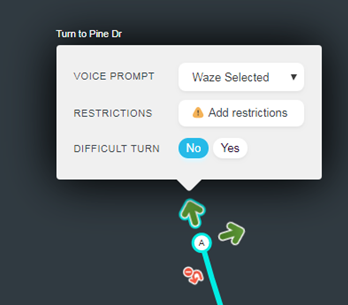
When in WME and you click on a segment and hover over a green or yellow turn connection/restriction arrow, a grey box will appear with the Voice prompt, the Time-based Turn Restriction (TBTR), and Difficult turn selectors. If the turn is red (restricted), then the grey box will not appear.
Click on the "Voice prompt" dropdown box to select the appropriate voice prompt.
Available options
When you click on the "Voice prompt" dropdown menu, you have the following choices:
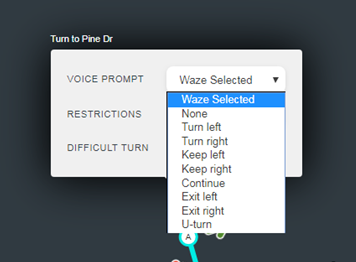
| Setting | Instruction Given |
|---|---|
| Waze Selected (default) | (this gives the default voice prompt) |
| None | No instruction is given |
| Turn left | The instruction "turn left" is given |
| Turn right | The instruction "turn right" is given |
| Keep left | The instruction "keep left" is given |
| Keep right | The instruction "keep right" is given |
| Continue | The instruction "continue straight" is given |
| Exit left | The instruction "exit left" is given |
| Exit right | The instruction "exit right" is given |
| U-turn | The instruction "make a U-turn" is given |
When something other than "Waze selected" is the selected option, the voice prompt override will appear in the "Voice prompt" selection box when you hover over a green or yellow turn arrow.
Identifying on the map
- The default way to determine whether a voice prompt has been overridden is to hover over the turn arrow.
- WME Toolbox helps to make identifying turns with voice prompt overrides in place.
Removal
To remove a voice prompt override, simply set the option back to Waze selected.
Example use cases
U-turn
This can be used with any dedicated median U turn segment (i.e., a segment in the median of a divided roadway that is used only for U turns). Use a "U-turn" voice prompt for the movement onto the dedicated median U turn segment and "None" on the movement off of the dedicated median U turn segment.
Turn
Streets meeting at less than 46 degrees
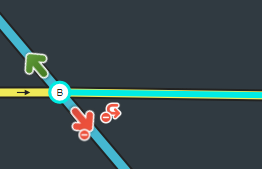
If drivers reaching a junction tend to slow and/or stop at an angle less than 46° to the crossroad, but a turn left or right instruction is still warranted, the appropriate "turn" voice prompt override should be used. Note that angles greater than 46° will issue turn instructions automatically.
Before Waze introduced override capability, editors forced turn instructions at such intersections by adding "dogleg" geometry nodes to ensure junction angles between 46° and 170° exclusive. When concerned about the display, editors added doglegs at such fine scale as to be nearly invisible; these are called "micro-doglegs". If you find a micro-dogleg, delete it and override voice prompts as needed.
Other pre-override instruction-forcing methods, especially short "segment to nowhere" stubs and deliberately incorrect alternate names, are similarly deprecated and should be replaced with voice prompt overrides.
Ambiguous turns
By default, Waze offers no instruction when two streets meet at their terminus and each can only turn into the other. In most cases, the necessary maneuver is obvious, and no instruction is required. However, if the turn is sharp and visibility is poor (e.g., due to steep grades, walls, buildings, or foliage) or the junction also involves an unmapped private, service, or parking lot road significant enough that the average driver could consider it a potential route, force a turn instruction to confirm the correct route.
At-grade connector
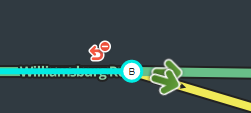
Depending on the length and angle of an at-grade connector, it may make sense for Waze to instruct either "keep right/left" or "turn right/left". Override the voice prompt when necessary to ensure the most appropriate instruction is given to the driver. An example of an at-grade connector using a voice prompt override is shown to the right.
Exit/keep
Exit left
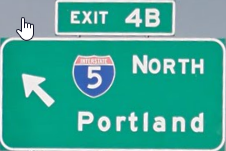

When there is a Big Green Sign (BGS) indicating an exit left, select the "Exit left" voice prompt. Note that this is the only way to get an "exit left" instruction in Waze.
Discuss with your Regional Coordinator(s) and/or State Manager(s) to see if they want it added to locations where an HOV or HOT/Express Lane is separated from the regular freeway, highway, etc.
Wayfinder
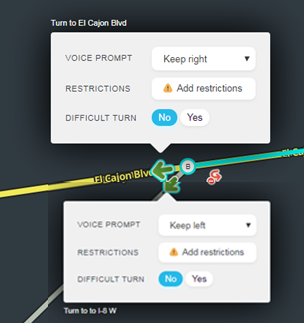
A simple wayfinder is a voice prompt override where an instruction would not normally be voiced. This is most often a "keep right," "keep left," or "continue." A basic example is a roadway with a split where left lanes turn left and right lanes go straight ahead.
To ensure the driver is kept on the correct side of the roadway to stay on the expected route, we add a voice prompt to ensure the driver is given enough advance notice to make sure they are on the correct side.
The image here is a composite showing both turns with the voice prompt set and which instructions have been applied in this specific case. To drivers continuing straight, the app will give the instruction "keep right to El Cajon Blvd." To drivers getting into the on-ramp, the app will say, "keep left to I-8 W."
A complex wayfinder is one where the s-out stubs are named differently than the subsequent segments. The stubs are named for the Big Green Sign (BGS) verbiage for clarity. Before overrides, complex wayfinders used unnatural road types to force instructions, but now these wayfinders should use correct road types and alternate names on the stubs where name continuity is to be preserved, along with voice prompt overrides to force instructions. See Wayfinder for further details.
Unusual on-ramp
A default surface-road-to-on-ramp "exit" instruction may be overridden with a "keep" in rare cases when either of the following conditions exist:
- The originating highway's continuation path is unclear (such situations often require wayfinders as well).
- The on-ramp's initial departure continues to share direction and pavement with the originating highway, either for an unexpectedly long distance or leading to two or more subsequent distributor on-ramps that are better instructed as exits than the initial departure. The latter application avoids issuing multiple "exit" instructions for what is effectively the same on-ramp.
Aside from the above situations, do not override the default "exit" instruction for shallow-angled on-ramp departures. While not immediately intuitive for new Wazers, "exit" is nevertheless Waze's current default voice prompt for these situations. Overriding this default on a large scale could lead to problems. Meanwhile, our only alternative, the "keep" instruction, is not always significantly clearer.
Continue
Unannounced roads with legal or financial implications
Restricted areas (border control point, military base)
When the best continuation is to a restricted area, add a Continue voice prompt, paired with a named stub segment if necessary, to let users know they will now be entering a restricted area.
Toll
When the best continuation is tolled, marked or unmarked (toll roads, bridges, paid entrances into large areas, etc.), add a Continue voice prompt, paired with a named stub segment if necessary. For barrier-toll systems, add the voice prompt only at the beginning of the toll area. Do not force a Continue at intermediate toll barriers.
Setting context in the instruction list
Without a Continue voice prompt, the next instruction could be from an entirely different road or freeway. Adding a Continue voice prompt would help set the context as to where the instructions are and increase the Wazer's confidence in the instructions given (or not given).
Terminus of a freeway
Where a freeway ends with a best continuation onto another freeway, add a Continue voice prompt to indicate the name of the continuing road.
When possible, do this at a point where the user can use this voice prompt to make a mental confirmation.
If the continuing freeway is signed before the terminus, place the voice prompt at the last exit, similar to how a wayfinder is set up today.
If it isn't signed, place the voice prompt where the freeway merges into the next freeway.
Consult with your state manager if the freeway status changes frequently or gradually, or if the freeway itself is insignificant. There could be multiple options as to what would be the best spot for a voice prompt, or if one is needed at all.
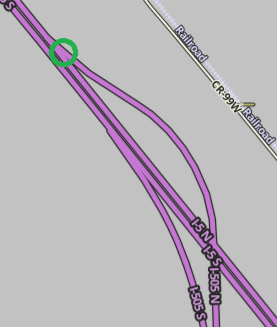 |
On-ramp to a freeway
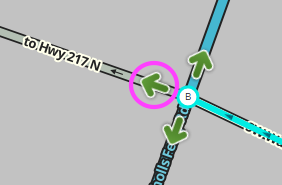
When the best continuation from a road (including off-ramps, parking lot roads, and rest areas) is an on-ramp to a freeway or expressway, add a continue voice prompt.
Continuing from an off-ramp
Use a Continue voice prompt when the name of the best continuation at the end of a ramp is not immediately obvious. Here are two scenarios that it's not immediately obvious:
Supplement a wayfinder
Because controlling the turn angles in Waze will never produce a continue instruction, a Continue voice prompt must be set in places where a wayfinder is warranted for a particular direction, but "keep" or "exit" would be misleading.
Add a continue voice prompt when:
- All travel lanes are correct—telling a user to "keep" or "exit" would mean an unnecessary lane change to that side of the road out of caution;
- Only the center lanes are correct in a 3-way fork; or
- One side of a wayfinder, and not the other, is the clear straight-ahead path.
Best continuation is not the obvious continuation
Many times, when there are many turn lanes, many vehicles turning, and a plethora of signage, and straight ahead doesn't look like the right way to go, the Wazer may be hesitant that Waze is not issuing an instruction. Add a continue voice prompt to help assure the Wazer that continuing straight is the correct way.
Use selectively, and consult your fellow area managers for consensus.
